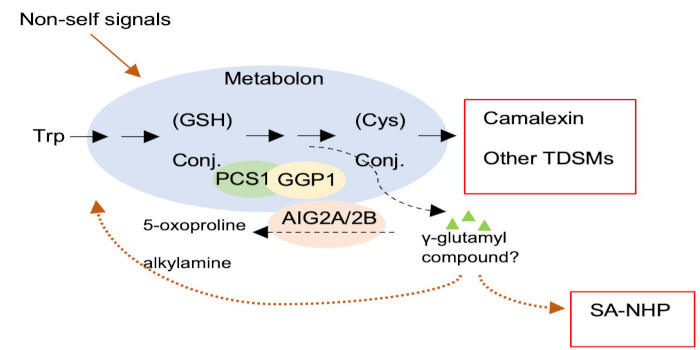AIG2 proteins fine tune plant chemical defense systems
Wang, Yang, et al. explore the connection between tryptophan-derived metabolites and salicylic acid defense responses. https://doi.org/10.1093/plcell/koac255
Zhixue Wang, Leiyun Yang, Jian Hua
Plant Biology Section, School of Integrative Plant Science, Cornell University, Ithaca, NY 14853, USA
Background: Plants synthesize diverse, sometimes species-specific, defensive molecules, including tryptophan-derived secondary metabolites (TDSMs) and/or salicylic acid (SA) to defend themselves. TDSMs are either toxic to invading pathogens or are able to activate downstream immune responses. They are generally produced upon recognition of non-self signals from both pathogenic and non-pathogenic microbes. By contrast, SA is induced by pathogens and activates defense responses usually at the cost of plant growth. These two chemical defense systems are thought to be largely independent. Through a genome-wide association study, we identified AVRRPT2 INDUCED GENE2A (AIG2A) and AIG2B as regulators of both TDSMs and SA chemical defense systems in Arabidopsis thaliana.
Questions: What is the role of AIG2A and AIG2B in regulating TDSMs and SA-mediated defense responses? Is there a connection between TDSMs and SA chemical defense systems?
Findings: In an AIG2A and AIG2B loss of function mutant (hereafter, aig2), the TDSMs and SA defense systems are both upregulated. Genetic removal of the TDSM biosynthesis pathway abolishes the upregulation of SA defense systems in the aig2 mutant, but not vice versa. Thereby, AIG2A and AIG2B function as gatekeepers that prevent the activation of SA defense systems by the TDSM defense system. AIG2A and AIG2B are co-localized with TDSM biosynthetic enzymes, and their gene expression is co-induced with TDSM genes by non-self signals, suggesting a role for AIG2A and AIG2B in TDSM metabolism. In addition, putative γ-glutamyl cyclotransferase (GGCT) catalytic sites in AIG2 and AIG2 are essential for the function of these proteins in plant immunity, suggesting that the substrate (or the product) of AIG2A and AIG2B functions as an immune signaling molecule.

Next steps: We are looking for the substrate(s) of AIG2A and AIG2B through multiple approaches, including high-resolution non-targeted metabolite profiling and genetic dissections. Successful identification of these substrates will generate new insights into the interaction of the SA and the TDSM defense systems.
Reference:
Zhixue Wang, Leiyun Yang, Georg Jander, Ruchika Bhawal, Sheng Zhang, Zhenhua Liu, Aaron Oakley, Jian Hua (2022) AIG2A and AIG2B limit the activation of salicylic acid-regulated defenses by tryptophan-derived secondary metabolism in Arabidopsis. https://doi.org/10.1093/plcell/koac255



